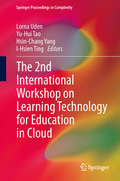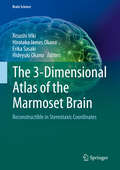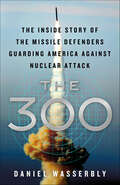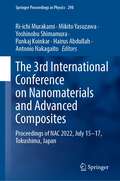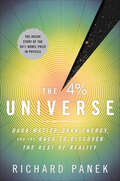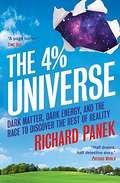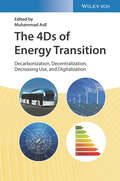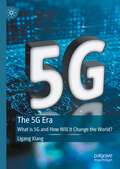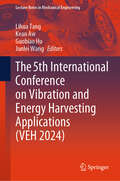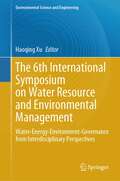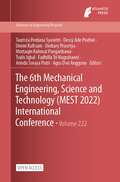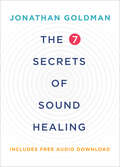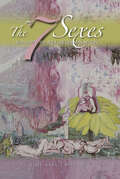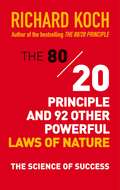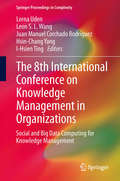- Table View
- List View
The 25th European Conference on Integrated Optics: Proceedings of ECIO 2024, June 17–19, Aachen, Germany (Springer Proceedings in Physics #402)
by Jeremy Witzens Joyce Poon Lars Zimmermann Wolfgang FreudeThis volume presents peer-reviewed and selected papers from the 2024 European Conference on Integrated Optics (ECIO), held on 17-19 June, 2024, and organized by RWTH Aachen University, Germany, in collaboration with Max-Planck Institute of Microstructure Physics, Technical University of Berlin, Leibniz Institute for High Performance Microelectronics, and Karlsruhe Institute of Technology. In the 25th edition of this conference, internationally recognized experts share their latest research and showcase their products and services in the field of integrated optics, optoelectronics, and nano-photonics. The conference focuses on leading-edge research and its broad application scope ranges from tele/datacom, optical interconnects, and (bio) optical sensing to more disruptive areas such as quantum computing and programmable photonics.
The 2nd International Workshop on Learning Technology for Education in Cloud
by Lorna Uden I-Hsien Ting Hsin-Chang Yang Yu-Hui TaoProceedings from the 2013 LTEC conference in Kaohsiung, Taiwan. The papers examine diverse aspects of Learning Technology for Education in Cloud environments, including social, technical and infrastructure implications. Also addressed is the question of how cloud computing can be used to design applications to support real time on demand learning using technologies. The workshop proceedings provide opportunities for delegates to discuss the latest research in TEL (Technology Enhanced Learning) and its impacts for learners and institutions, using cloud technologies.
The 3-Dimensional Atlas of the Marmoset Brain: Reconstructible In Stereotaxic Coordinates (Brain Science)
by Atsushi Iriki Hirotaka James Okano Erika Sasaki Hideyuki OkanoThis book provides accurate, comprehensive, and convenient reference for usages of the “freely rotatable three dimensional combined Nissl-stained and MRI digital data of the marmoset brain”. The key features of the original 3D digital data and of this atlas are: 1. The original digital datasets are freely rotatable in three dimensions, thus expected to be useful for any disciplines and anatomical interest, using any coordinate system, 2. Combined Nissl stained and MRI images are obtained from the same marmoset, to allow cross-modality matched references for multiple usages, 3. 86 Horizontal Series of Images with Neurosurgical Plane (based on the actual data), with more accuracy and resolution (Chapter 2) than the web-based digital images, 4. 32 Coronal Series of Images with Neurosurgical Plane (reproduced from the brain model) (Chapter 3), 5. 10 Parasagittal Series of Images with Neurosurgical Plane (reproduced from the brain model) (Chapter 4), 6. 3 Omnidirectionally Sliceable Planes (reproduced from the brain model) (Chapter 5), 7. In order to provide higher resolution structures to match systematic accuracy for supplementation of the digital data on the website, additional information are included. They are: 1) Nomenclature, 2) List of Brain Structures in Hierarchical Order, 3) Index of Abbreviations, together with 143 useful Bibliographic References list as of 2016, 8. Horsley-Clarke’s stereotaxic coordinates were adopted in the present atlas.
The 300: The Inside Story of the Missile Defenders Guarding America Against Nuclear Attack
by Daniel WasserblyMilitary and security expert Daniel Wasserbly introduces the elite unit tasked with protecting the nation from long-range weapons of mass destruction.Comprised of just three hundred soldiers, the United States Army’s 100th Missile Defense Brigade and 49th Missile Defense Battalion utilize sophisticated and cutting-edge technology to monitor the skies and seas surrounding the country and shield three hundred million Americans against any potential nuclear threat. Named for the number of Spartan warriors who defended Greece at the Battle of Thermopylae, these vigilant individuals endure rigorous, always-evolving regimens to maintain peak efficiency in the event of an actual nuclear strike.Assigned to extraordinary locations at Fort Greely, Alaska and Schriever Air Force Base, Colorado, the 300 are responsible for the highest levels of homeland security. They not only maintain a never-ending watch via radar and sensor arrays, but receive continuous training in operating advanced interceptors designed to home in on and destroy in-flight ballistic missiles. It’s a complex—and occasionally unreliable—defense system that scientists and engineers are always improving and upgrading.With unprecedented access to the highly classified strategic nerve centers of U.S. Northern Command in Cheyenne Mountain, years of research, and dozens of exclusive interviews with normally inaccessible missile crews, Wasserbly reveals the incredible true story behind the 300’s essential defense operations.
The 37th Parallel: The Secret Truth Behind America's UFO Highway
by Ben MezrichThis real-life The X-Files and Close Encounters of the Third Kind tells the true story of a computer programmer who tracks paranormal events along a 3,000-mile stretch through the heart of America and is drawn deeper and deeper into a vast conspiracy.Like "Agent Mulder" of The X-Files, computer programmer and sheriff's deputy Zukowski is obsessed with tracking down UFO reports in Colorado. He would take the family with him on weekend trips to look for evidence of aliens. But this innocent hobby takes on a sinister urgency when Zukowski learns of mutilated livestock, and sees the bodies of dead horses and cattle--whose exsanguination is inexplicable by any known human or animal means. Along an expanse of land stretching across the southern borders of Utah, Colorado, and Kansas, Zukowski discovers multiple bizarre incidences of mutilations, and suddenly realizes that they cluster around the 37th Parallel or "UFO Highway." So begins an extraordinary and fascinating journey from El Paso and Rush, Colorado, to a mysterious space studies company and MUFON, from Roswell and Area 51 to the Pentagon and beyond; to underground secret military caverns and Indian sacred sites; beneath strange, unexplained lights in the sky and into corporations that obstruct and try to take over investigations. Inspiring and terrifying, this true story will keep you up at night, staring at the sky, and wondering if we really are alone...and what could happen next.
The 3rd International Conference on Nanomaterials and Advanced Composites: Proceedings of NAC 2022, July 15-17, Tokushima, Japan (Springer Proceedings in Physics #298)
by Ri-Ichi Murakami Hairus Abdullah Mikito Yasuzawa Yoshinobu Shimamura Pankaj Koinkar Antonio NakagaitoThis book presents selected articles from the 3rd International Conference on Nanomaterials and Advanced Composites (NAC 2022) held at Tokushima University in Japan. This event brought together leading researchers and professionals from academia and industry to present their latest findings and served as a platform for the exchange of ideas aiming for further collaborations. Participants from over six countries shared their most up-to-date knowledge in their respective fields covering nanotechnology, nanomaterials, and advanced composites. Even though this conference had both on-site and remotely connected attendees, the main purpose to promote the networking among academics, engineers, and students was fully achieved. This book is part of the effort to disseminate the knowledge gathered during this meeting. The collection of articles covers topics on advanced composites, nanomaterials, ecological materials, energy, microfluidics, crystal growth, and photocatalysis. This representative account of the conference is intended to provide new and useful insights for prospective studies in materials science and engineering.
The 4% Universe: Dark Matter, Dark Energy, and the Race to Discover the Rest of Reality
by Richard PanekThe epic, behind-the-scenes story of an astounding gap in our scientific knowledge of the cosmos.In the past few years, a handful of scientists have been in a race to explain a disturbing aspect of our universe: only 4 percent of it consists of the matter that makes up you, me, our books, and every planet, star, and galaxy. The rest—96 percent of the universe—is completely unknown. Richard Panek tells the dramatic story of how scientists reached this conclusion, and what they’re doing to find this "dark" matter and an even more bizarre substance called dark energy. Based on in-depth, on-site reporting and hundreds of interviews—with everyone from Berkeley’s feisty Saul Perlmutter and Johns Hopkins’s meticulous Adam Riess to the quietly revolutionary Vera Rubin—the book offers an intimate portrait of the bitter rivalries and fruitful collaborations, the eureka moments and blind alleys, that have fueled their search, redefined science, and reinvented the universe.
The 4-Percent Universe: Dark Matter, Dark Energy, and the Race to Discover the Rest of Reality
by Richard PanekIt is one of the most disturbing aspects of our universe: only four per cent of it consists of the matter that makes up every star, planet, and every book. The rest is completely unknown. Acclaimed science writer Richard Panek tells the story of the handful of scientists who have spent the past few decades on a quest to unlock the secrets of "dark matter" and the even stranger substance called "dark energy". These are perhaps the greatest mysteries in science,and solving them will reshape our understanding of the universe and our place in it. The stakes could not be higher. Panek's fast-paced narrative, filled with original, in-depth reporting and intimate, behind-the-scenes details, brings this epic story to life for the very first time.
The 4Ds of Energy Transition: Decarbonization, Decentralization, Decreasing Use, and Digitalization
by Muhammad AsifThe 4Ds of Energy Transition Enables readers to understand technology-driven approaches that address the challenges of today’s energy scenario and the shift towards sustainable energy transition This book provides a comprehensive account of the characteristics of energy transition, covering the latest advancements, trends, and practices around the topic. It charts the path to global energy sustainability based on existing technology by focusing on the four dynamic approaches of decarbonization, decreasing use, decentralization, and digitalization, plus the important technical, economic, social and policy perspectives surrounding those approaches. Each technology is demonstrated with an introduction and a set of specific chapters. The work appropriately incorporates up-to-date data, case studies, and comparative assessments to further aid in reader comprehension. Sample topics discussed within the work by key thinkers and researchers in the broader fields of energy include: Renewable energy and sustainable energy future Decarbonization in energy sector Hydrogen and fuel cells Electric mobility and sustainable transportation Energy conservation and management Distributed and off-grid generation, energy storage, and batteries Digitalization in energy sector; smart meters, smart grids, blockchain This book is an ideal professional resource for engineers, academics, and policy makers working in areas related to the development of energy solutions.
The 50 State Fossils: A Guidebook for Aspiring Paleontologists
by Yinan WangAn award-winning engaging kids' guide to the official US state fossils. Did you know that Illinois's state fossil is the weird-looking Tully Monster, which had eyes on a pair of stalks and an elephant-like trunk that ended in a toothed claw? Or that Idaho's state fossil is the stocky Hagerman horse, named for the town where its bones were found? Fossils can be found in every state, and this engaging guidebook brings these ancient organisms to life. Each state entry contains details about the state fossil; an illustration of what the vertebrate, invertebrate, or plant looked like; a photograph or drawing of the fossil; and a state map showing where it can be found. Potential fossil candidates are proposed for states that do not yet have official state fossils, along with instructions on how to get state fossils designated. An appendix lists museums and parks where these fossils can be studied first-hand. This book is a fun resource for fossil enthusiasts and future paleontologists of all ages.
The 5Es of Inquiry-Based Science
by Lakenna Chitman-Booker and Kathy KoppThis resource supports core concepts of STEM instruction and specifically addresses the connection between technology and the 5Es. Adapting to the changing technological worldis crucial in all fields of education, and The 5Es of Inquiry-Based Science helps teachers integrate their instruction strategies to incorporate technology while meeting the demands of today’s science standards (both quantitative and qualitative). With this resource, teachers can effectively promote a positive culture about inquiry and encourage active, engaged participation from students.
The 5G Era: What is 5G and How Will it Change the World?
by Ligang XiangThis book states that the seventh information revolution is the intelligent Internet, and 5G is the foundation of the seventh information revolution. This book gives a clear introduction to the three major scenarios, six characteristics, core technologies, and global landscape of 5G, and answers "What is true 5G?" This book also gives an in-depth explanation of 5G-enabled traditional industries, and outlines the profound changes that 5G will bring to transportation, medical, industry, and agriculture. Finally, the author made bold assumptions about the opportunities and challenges that human society faces in the post-5G era. For readers who want to fully understand 5G, this book provides an important reference and is a must-have book.
The 5th International Conference on Vibration and Energy Harvesting Applications (Lecture Notes in Mechanical Engineering)
by Lihua Tang Kean Aw Guobiao Hu Junlei WangThis book presents select proceedings of the 5th International Conference on Vibration and Energy Harvesting Applications (VEH 2024). This book covers latest research and technological advances in the field of vibration analysis, energy harvesting, and its applications. Topics covered in the book include innovative research works related to vibration analysis, energy harvesting, their applications, and results on the mechanical design, optimization, dynamics, power management circuits and systems, MEMS technology, nanotechnology, new materials, self-powered IoT applications, and other related areas.. The book can be a valuable reference for researchers and professionals interested in vibration analysis, energy harvesting, its applications, and allied fields.
The 6th International Symposium on Water Resource and Environmental Management: Water-Energy-Environment-Governance from Interdisciplinary Perspectives (Environmental Science and Engineering)
by Haoqing XuThis book is designed to be the introductory work in the Water-Energy-Environment-Governance from Interdisciplinary Perspectives Series and provides an in-depth look at sustainable development and management in the water sector across. The water-energy-environment nexus (WEEN) represents important interstate connections of water, energy, and the environment. Present day water and energy systems are interdependent. Water is used in all phases of energy production and electricity generation. Energy is required to extract, convey, and deliver water of appropriate quality for diverse human uses and then again to treat waste waters prior to their return to the environment. Security in water, energy, and the environment is associated with human, economic, and environmental sustainability. This interweaving is strengthening under aggregating natural resource scarcity and climate change. This book includes selected papers from the 6th International Symposium on Water Resource and EnvironmentalManagement (WREM 2023) and consists of themes pertaining to water resource and environmental management. It provides readers with comprehensive information, and formulation of solutions leading to a set of Water-Energy-Environment-Governance from Interdisciplinary Perspectives through our forum and the publication of your research. As a reference, it is of interest to students, scientists, engineers, government officials, and water resource managers.
The 6th Mechanical Engineering, Science and Technology (Advances in Engineering Research #222)
by Taurista Perdana Syawitri Dessy Ade Pratiwi Ummi Kultsum Dediary Prasetya Muttaqin Rahmat Pangaribawa Tsulis Iqbal Fadhilla Tri Nugrahaeni Arinda Soraya Putri Agus Dwi AnggonoThis is an open access book.MEST2022 invites all potential authors from universities and various organisations to submit papers in the area of mechanical, manufacturing, materials sciences and related interdisciplinary engineering fields. This conference is part of a conference program called International Summit on Science Technology and Humanity (ISETH) 2022 Organized by Universitas Muhammadiyah Surakarta.The 6th Mechanical Engineering, Science and Technology (MEST2022) International conference is an annual the Mechanical Department of Universitas Muhammadiyah Surakarta event. All possible writers from universities and other organizations are invited to submit papers. The conference is a forum for academic exchange that provides a prompt presentation of articles on experimental, numerical, and theoretical studies that shed light on the critical topics of mechanical, thermal, fluid, and aerothermodynamics internal flow, heat and mass transfer, multiphase flow, turbulence modelling, combustion, engineering thermodynamics, thermophysical properties of matter, measurement, and visualization techniques. Contributions range from intriguing and significant research immediately applicable to industry development or practice to high-level student textbooks, explanations, distribution of technology, and good practice.
The 7 Secrets of Sound Healing Revised Edition: Revised Edition
by Jonathan GoldmanThe effect of sound is unquestionably powerful, with a remarkable ability to heal and restore balance from the inside to out. By breaking down scientific principles and studies into accessible, understandable, and applicable wisdoms and techniques, sound healing pioneer Jonathan Goldman reveals how sound can be used to as personal vibrational therapy for your mind, body, and spirit. Journey into the realm of sound through learning: the basic principles of vibration the importance of your intent the uniqueness of sound to everyone the importance of silence our own voice’s healing properties the diverse healing applications of sound the global, all-encompassing effect of sound Practical information and exercises provide an interactive understanding of using sound as a healing modality, while Goldman’s exploration of a variety of ancient and modern techniques will guide you into living a more harmonious life. Goldman’s guided meditations and exercises in his free audio download are specifically designed to enhance your relaxation and healing, helping to bring the seven core secrets of sound healing into your heart and home.
The 7 Sexes: Biology of Sex Determination
by Elof Axel CarlsonWhat makes us male or female? A geneticist explains the history of scientific research into human sexuality and reproduction.In this book, geneticist and science historian Elof Carlson tells the incredible story of the difficult quest to understand how the body forms girls and boys. Carlson’s history takes us from antiquity to the present day to detail how each component of human reproduction and sexuality was identified and studied, how this knowledge enlarged our understanding of sex determination, and how it was employed to interpret such little understood aspects of human biology as the origin of intersex births.“Reveals the various scientific advances, in both methods and understanding, that allowed researchers to identify anatomical structures, gametes, sex hormones, sex chromosomes, and ultimately, a firm comprehension of the genetics of sex. . . . This scientific story of discovery is quite fascinating.” —Barbara Baumgartner, Washington University, St. Louis
The 80/20 Principle and 92 Other Powerful Laws of Nature
by Richard KochIn this follow-up to his best-selling The 80/20 Principle, the power law that helped hundreds of thousands achieve more by doing less, Richard Koch puts science to work, applying ninety-two other natural laws to promote the "science of success" within the ever-changing world of business. What does Charles Darwin's theory of natural selection prove about developing a niche product line? How can Isaac Newton's laws of motion and gravity help in a crowded marketplace? This is a must-have book for business leaders looking for clear, evidence-based reasoning that explains why some companies seem to find success everywhere they turn, while others don't make progress.
The 80/20 Principle and 92 Other Powerful Laws of Nature: The Science of Success
by Richard KochIn a brand new Preface, bestselling author Richard Koch describes a paradigm shift in business, whereby intuition is more important than analysis, ideas and product trump strategy, and influence is superior to control. In this essential companion to his bestselling The 80/20 Principle - the radical power law that helped thousands of people achieve more by doing less - Koch illuminates 92 other universal principles and laws to promote the science of success in an increasingly challenging business environment.
The 8th International Conference on Advances in Construction Machinery and Vehicle Engineering: ICACMVE 2023 (Lecture Notes in Mechanical Engineering)
by Hao Zhang Saman K. Halgamuge Dingxuan Zhao Yongming BianThis open access book presents select contributions from the 8th International Conference on Advances in Construction Machinery and Vehicle Engineering (ICACMVE 2023), focusing on the recent advances and best practices of Construction Machinery and Vehicle Engineering, related technologies and sciences to meet the challenges in mechanical design, mechanical control and smart manufacturing. The contents focus on design engineering, automation in engineering, construction machinery, intelligence applications, new energy and others. Some of the topics discussed here include advanced manufacturing technologies, industrial engineering and automation, design of mechanical systems, control engineering, automobile engineering, performance analysis of energy systems, thermal modelling and simulations of different systems, optimization and intelligence. The wide range of topics presented in this book will be useful for beginners, researchers, and mechanical engineering professionals.
The 8th International Conference on Knowledge Management in Organizations: Social and Big Data Computing for Knowledge Management
by Lorna Uden I-Hsien Ting Hsin-Chang Yang Leon S.L. Wang Juan Manuel Corchado RodríguezThe proceedings from the eighth KMO conference represent the findings of this international meeting which brought together researchers and developers from industry and the academic world to report on the latest scientific and technical advances on knowledge management in organizations. This conference provided an international forum for authors to present and discuss research focused on the role of knowledge management for innovative services in industries, to shed light on recent advances in social and big data computing for KM as well as to identify future directions for researching the role of knowledge management in service innovation and how cloud computing can be used to address many of the issues currently facing KM in academia and industrial sectors.
The 9th International Conference on Advances in Construction Machinery and Vehicle Engineering: ICACMVE 2024 (Lecture Notes in Mechanical Engineering)
by Yan Peng Dingxuan Zhao Yongming Bian Halgamuge SamanThis open access book presents the proceedings of the 9th International Conference on Advances in Construction Machinery and Vehicle Engineering (ICACMVE 2024), highlighting the latest advancements and innovative practices in the field. Focusing on the challenges in mechanical design, control systems, and smart manufacturing, the selected papers cover a range of topics including innovative design strategies, intelligent systems and autonomous technologies, electrification and sustainable development, and reliability monitoring. By showcasing cutting-edge research and real-world applications, this volume aims to serve as a vital resource for students, researchers, and professionals in mechanical engineering, encouraging ongoing advancements that enhance efficiency, safety, and sustainability in construction machinery and vehicle engineering.
The A B C of Nerves (Psychology Revivals)
by D.F. Fraser-HarrisOriginally published in 1928, the preface reads: "It is almost impossible to distinguish between what is ‘elementary’ and what is ‘advanced’ in regard to the nervous system. The constitution and functions of that system are so little matters of common knowledge that it would be safe to assume that practically nothing of its physiology is known to the ordinary reader. The selection of what is necessary to be known and likely to be comprehended by readers who have no previous knowledge of anatomy and physiology is, therefore, no easy task. It is certain that in the opinion of some authorities much has been omitted that should have been included; one can but say in self-defence that to have included more than is here considered would have exceeded the limits of a treatise whose title is the A B C." Today it can be read and enjoyed in its historical context.
The A in STEAM: Lesson Plans and Activities for Integrating Art, Ages 0–8
by Jerilou J Moore Kerry P HolmesDiscover new and exciting ways to teach STEM content through the arts in your early childhood program with this innovative and comprehensive guidebook. Chapters feature playful activities divided by age band that bridge early academic learning and social, emotional, physical, and mental development with active engagement in the arts. Structured activities include a materials list, safety concerns, key takeaways, and related readings, as well as explicit connections to research and national standards. With clear and concise lesson plans that walk you through activities in music, dance, media arts, visual arts, and theater, it becomes easy to bring development and learning through movement and creativity to your classroom or program.

